Piping Plover Conservation in the Battle River and Sounding Creek Watersheds
By Stephanie Shyshka (University of Alberta Community Service-Learning student)
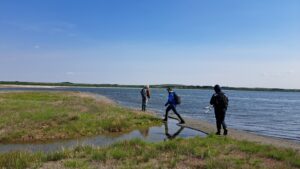
Battle River Watershed Alliance (BRWA) is dedicated to preserving and enhancing land, water, and biodiversity within the Battle River and Sounding Creek watersheds. These watersheds span vast areas of land, encompassing many kilometers of environmentally significant areas. Killarney, Dillberry, and Leane Lakes Important Bird Area (IBA) is one such location. It is a unique cluster of alkali lakes close to the AB/SK border, and current candidate for redesignation as the Reflex, Killarney, and Freshwater Lakes Key Biodiversity Area (KBA) because of its critical importance for the protection and monitoring of the Endangered Piping Plover.
The Piping Plover is a migratory shorebird endemic to North America, listed as Endangered through COSEWIC since 1985. The interior subspecies, Charadrius melodus circumcinctus, breeds on Canadian prairies in very sparse, specific locations. The proposed Reflex, Killarney and Freshwater Lakes KBA supports a nationally significant breeding population of Piping Plover, with portions of the existing IBA already designated as critical habitat for this species. Historic IBA boundaries of the Killarney, Dillberry and Leane Lakes site included Leane and Dillberry lakes; Leanne last had plovers in 2001, and Dillberry has never had plovers recorded. Redesignation to a KBA would delineate more recent locations of known nesting sites and enhance conservation efforts in these key ecological areas. Proposed new boundaries include several important lakes for the Piping Plover: Reflex (Salt) Lake, Cipher Lake, Killarney Lake, and Freshwater Lake (see Figure 1).
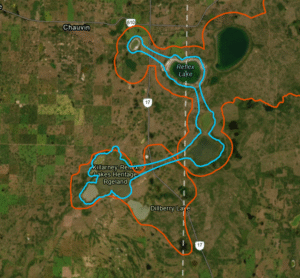
IBAs and KBAs Defined
IBAs are “sites identified as being internationally significant for the conservation of birds and other biodiversity” (Birdlife). In Canada, nearly 600 IBAs have been identified as part of a global effort to identify, monitor and conserve the world’s most critical sites for birds and biodiversity (IBA Canada). Sites identified as IBAs are known to support significant populations of at-risk species and help establish conservation reserves, guide land use decisions, and engage stewards throughout Regional Caretaker Networks. These locations are foundational in determining KBAs, sites contributing significantly to the global persistence of biodiversity (KBA Canada). KBAs harbor threatened and geographically restricted biodiversity; have high ecological integrity; support biological processes such as breeding, migration and staging; and/or are irreplaceable (Birds Canada). KBA data is consolidated into one comprehensive global database, which can be used to determine target areas for stewardship, enhanced management, formal protection and/or other conservation measures (KBA Canada).
BRWA is the local caretaker of the existing Killarney, Dillberry and Leane Lakes IBA, actively participating in its responsible management and protection of ecological integrity. The IBA and proposed KBA boundaries are located within the Sounding Creek watershed. Local land uses range from private agricultural land to public recreation areas, including Dillberry Lake Provincial Park. This mixed land-use designation makes environmental management dynamic and complex. Increasingly so, once biodiversity and at-risk species management are considered.
Piping Plover Habitat and Population Trends
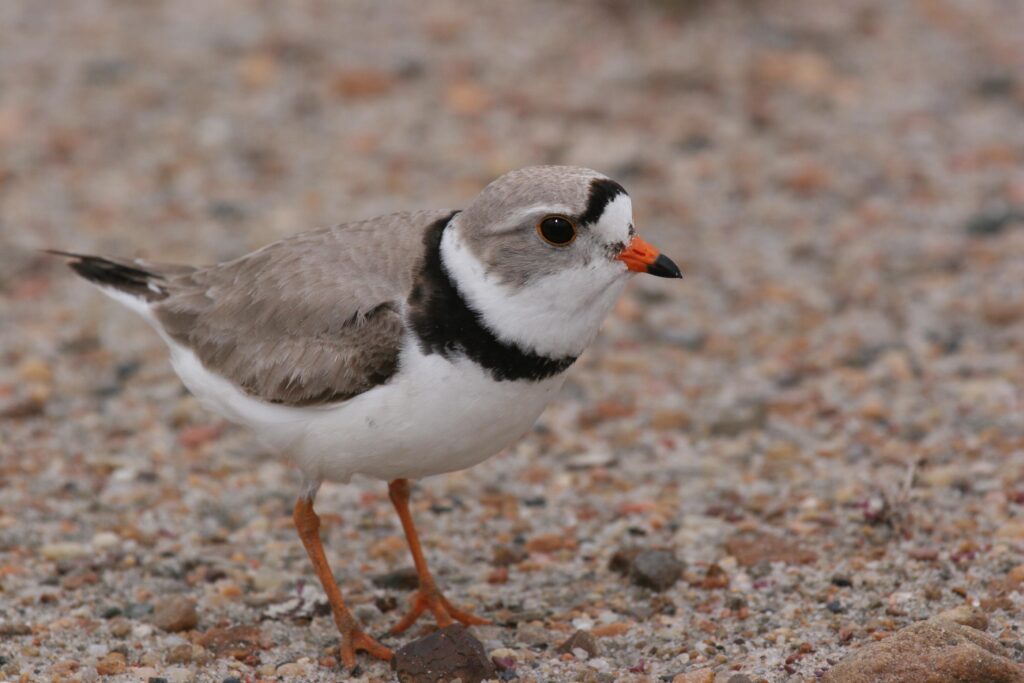
The Piping Plover is one of many important bird species that migrate to and nest within this region (see Figure 2 for the species distribution map). In Alberta, Piping Plovers arrive in early May, and the breeding season lasts through mid-August. These ground-nesting birds are particular about their nesting habitat, often returning to the same areas over several consecutive years. During nesting season, four eggs are typically laid, and they may re-nest if their first nest fails.
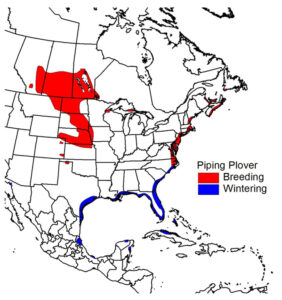
Very specific requirements must be met for plovers to deem an area suitable for nesting. They prefer rocky, sandy shorelines with wide beaches comprised of a mix of substrates. Beaches must have minimal vegetation coverage. Alkali lakes are their preferred habitat in Alberta, though plovers have also been found at reservoirs and freshwater lakes. Several lakes in the Battle River and Sounding Creek watersheds provide important Piping Plover habitat (see Figure 3).
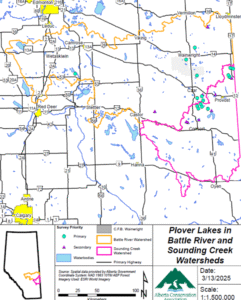
Plover counts have occurred annually in Alberta since 2001, with large-scale recovery efforts beginning in 2002 through the combined efforts of the Alberta Conservation Association (ACA) and the Alberta Government. The plover population has been on a steady decline over the past 15 years and has only recently shown signs of stabilizing (Figure 4). In 2025, 32 mature individuals were reported in the proposed KBA, emphasizing the critical importance of this area for the protection of Piping Plovers.
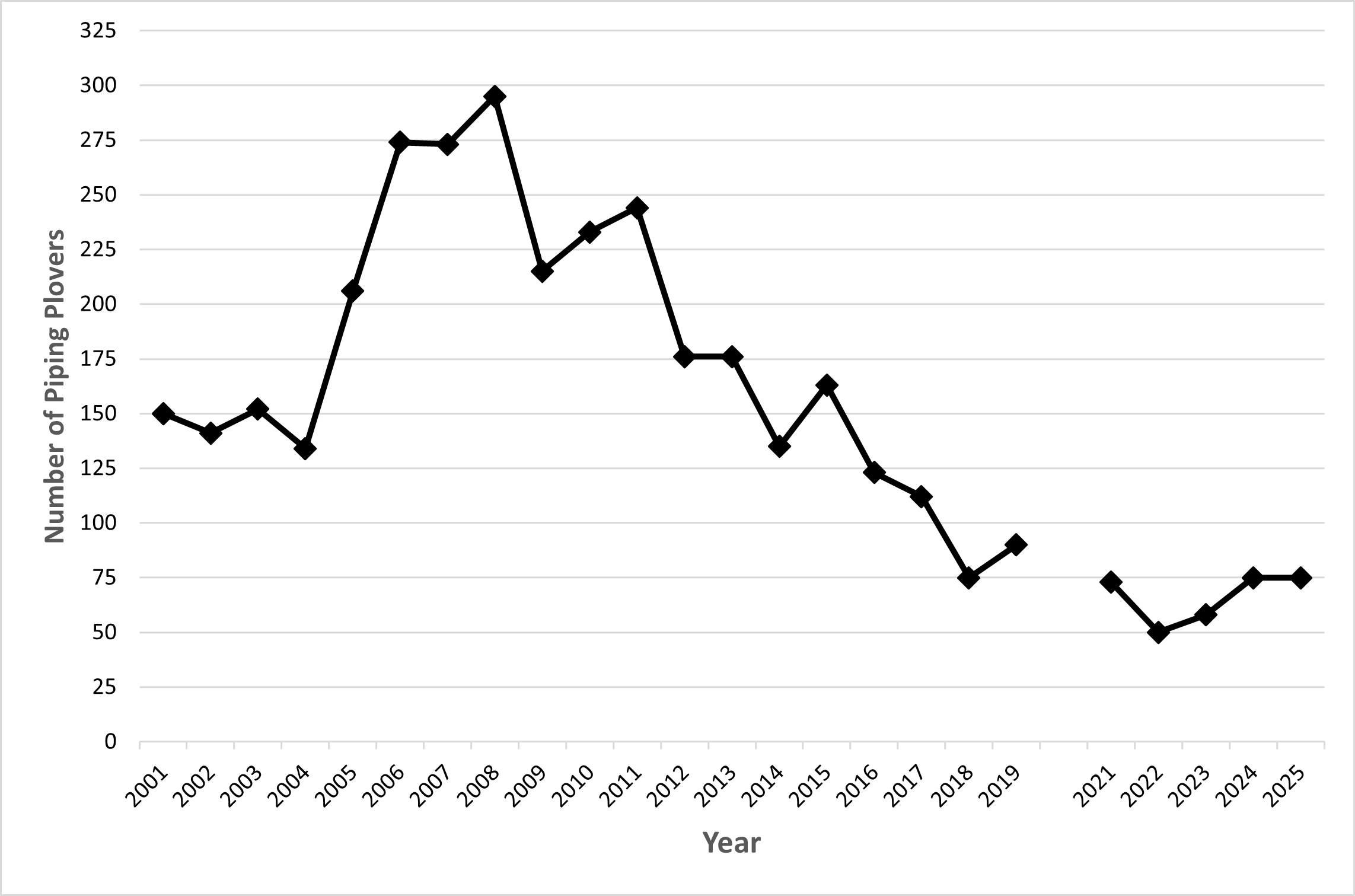
Piping Plover Threats and Challenges
Ongoing threats and challenges to Piping Plovers are largely a result of predation, human disturbance, and habitat loss and/or degradation. Predation threats are often against eggs and chicks; common predators include foxes, skunks, coyotes, gulls, crows, and other corvids. Human disturbance can be direct (e.g. driving ATVs over nests) or indirect (e.g. distracting birds from nesting or feeding, leaving tire tracks on beaches which can increase vegetation encroachment). Habitat loss and degradation may be attributed to a number of factors, including human disturbance, development, resource extraction, recreational use, grazing livestock, and declining water levels (see Figure 5 and 6). Severe weather events can also impact Piping Plovers. Changing precipitation patterns impact water levels in key habitat areas, and fluctuating water levels are important for Piping Plovers. High water levels flood beaches and kill vegetation, then when water levels recede large expanses of unvegetated habitat are exposed. However, prolonged drought or sustained high water can reduce breeding habitat, either through vegetation encroachment during drought or through persistent flooding of beaches. Migratory patterns and food availability are also a concern due to increasing variability in annual weather patterns (COSEWIC).
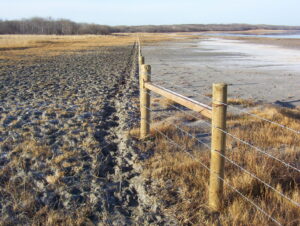
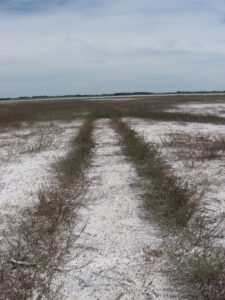
Taking Action to Support Piping Plovers
In the face of looming threats, caretaker activity is increasingly important. The Caretaker Network is a major pillar of the IBA program. This network is comprised of on-the-ground volunteers who are local to, and knowledgeable about, their conservation areas. Caretakers monitor their IBA for changes and/or threats to ecological integrity, documenting any concerns and working to have them resolved (IBA Canada). These individuals are stewards of the land, taking action to care for and maintain ecosystem and biodiversity health. Caretaker activities vary depending on site characteristics and interests but can include: collecting bird data; population counts; conducting site assessments – monitoring, reporting on threats; habitat restoration; raising community awareness; and other stewardship efforts (IBA Canada).
Beneficial land management practices support conservation of key ecosystems and species-at-risk like the Piping Plover. Land use practices have a profound impact on surface water quality because contaminants may be carried from upland areas into water bodies (BRWA). Community engagement and outreach are crucial components in developing effective land management practices. Many key ecosystems are located on privately owned land across the watershed, and as such, it is paramount that conservation efforts are collegial. Many steps can be taken to improve watershed health and protect critically important ecological habitats.
Partners in Conservation
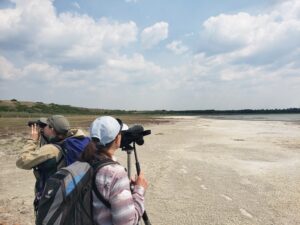
Many partner organizations work to help conserve and maintain the biodiversity of important ecosystems. Some key players in local conservation efforts include:
Many opportunities exist to join in conservation efforts and help conserve and maintain ecological integrity within our watersheds. Please see the following sources for more information on environmental conservation, such as bird counts and banding, education programs, and caretaking activities. The Caretaker Network has multiple resources available.
Thank you to ACA for their review of the content of this blog, and for inviting BRWA staff to join their Piping Plover monitoring efforts in Spring 2025.